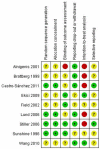Massage therapy for fibromyalgia: a systematic review and meta-analysis of randomized controlled trials
- PMID: 24586677
- PMCID: PMC3930706
- DOI: 10.1371/journal.pone.0089304
Massage therapy for fibromyalgia: a systematic review and meta-analysis of randomized controlled trials
Abstract
Background: Although some studies evaluated the effectiveness of massage therapy for fibromyalgia (FM), the role of massage therapy in the management of FM remained controversial.
Objective: The purpose of this systematic review is to evaluate the evidence of massage therapy for patients with FM.
Methods: Electronic databases (up to June 2013) were searched to identify relevant studies. The main outcome measures were pain, anxiety, depression, and sleep disturbance. Two reviewers independently abstracted data and appraised risk of bias. The risk of bias of eligible studies was assessed based on Cochrane tools. Standardised mean difference (SMD) and 95% confidence intervals (CI) were calculated by more conservative random-effects model. And heterogeneity was assessed based on the I(2) statistic.
Results: Nine randomized controlled trials involving 404 patients met the inclusion criteria. The meta-analyses showed that massage therapy with duration ≥ 5 weeks significantly improved pain (SMD, 0.62; 95% CI 0.05 to 1.20; p = 0.03), anxiety (SMD, 0.44; 95% CI 0.09 to 0.78; p = 0.01), and depression (SMD, 0.49; 95% CI 0.15 to 0.84; p = 0.005) in patients with FM, but not on sleep disturbance (SMD, 0.19; 95% CI -0.38 to 0.75; p = 0.52).
Conclusion: Massage therapy with duration ≥ 5 weeks had beneficial immediate effects on improving pain, anxiety, and depression in patients with FM. Massage therapy should be one of the viable complementary and alternative treatments for FM. However, given fewer eligible studies in subgroup meta-analyses and no evidence on follow-up effects, large-scale randomized controlled trials with long follow-up are warrant to confirm the current findings.
Conflict of interest statement
Figures








Similar articles
-
Effectiveness of Tai Chi on fibromyalgia patients: A meta-analysis of randomized controlled trials.Complement Ther Med. 2019 Oct;46:1-8. doi: 10.1016/j.ctim.2019.07.007. Epub 2019 Jul 10. Complement Ther Med. 2019. PMID: 31519264
-
Is immediate imaging important in managing low back pain?J Athl Train. 2011 Jan-Feb;46(1):99-102. doi: 10.4085/1062-6050-46.1.99. J Athl Train. 2011. PMID: 21214357 Free PMC article.
-
Low-Level Laser Therapy for Fibromyalgia: A Systematic Review and Meta-Analysis.Pain Physician. 2019 May;22(3):241-254. Pain Physician. 2019. PMID: 31151332
-
Massage therapy significantly improves cancer-related fatigue in cancer patients: a meta-analysis of randomized controlled trials.Support Care Cancer. 2023 Jul 15;31(8):464. doi: 10.1007/s00520-023-07926-w. Support Care Cancer. 2023. PMID: 37452895 Review.
-
An overview of systematic reviews of complementary and alternative medicine for fibromyalgia.Clin Rheumatol. 2012 Jan;31(1):55-66. doi: 10.1007/s10067-011-1783-5. Epub 2011 May 26. Clin Rheumatol. 2012. PMID: 21614472 Review.
Cited by
-
Manual Therapy Improves Fibromyalgia Symptoms by Downregulating SIK1.Int J Mol Sci. 2024 Sep 1;25(17):9523. doi: 10.3390/ijms25179523. Int J Mol Sci. 2024. PMID: 39273470 Free PMC article.
-
Is massage a legitimate part of nursing care? A qualitative study.PLoS One. 2023 Feb 27;18(2):e0281078. doi: 10.1371/journal.pone.0281078. eCollection 2023. PLoS One. 2023. PMID: 36848354 Free PMC article.
-
Unraveling the Molecular Determinants of Manual Therapy: An Approach to Integrative Therapeutics for the Treatment of Fibromyalgia and Chronic Fatigue Syndrome/Myalgic Encephalomyelitis.Int J Mol Sci. 2018 Sep 9;19(9):2673. doi: 10.3390/ijms19092673. Int J Mol Sci. 2018. PMID: 30205597 Free PMC article. Review.
-
Massage for Pain: An Evidence Map.J Altern Complement Med. 2019 May;25(5):475-502. doi: 10.1089/acm.2018.0282. Epub 2019 Mar 20. J Altern Complement Med. 2019. PMID: 30892910 Free PMC article.
-
Body-Centered Interventions for Psychopathological Conditions: A Review.Front Psychol. 2020 Jan 24;10:2907. doi: 10.3389/fpsyg.2019.02907. eCollection 2019. Front Psychol. 2020. PMID: 32038351 Free PMC article. Review.
References
-
- Ge HY, Wang Y, Danneskiold-Samsoe B, Graven-Nielsen T, Arendt-Nielsen L (2010) The predetermined sites of examination for tender points in fibromyalgia syndrome arefrequently associated with myofascial trigger points. J Pain 11: 644–651. - PubMed
-
- Wolfe F, Smythe HA, Yunus MB, Bennett RM, Bombardier C, et al. (1990) The American College of Rheumatology 1990 criteria for the classification of fibromyalgia. report of the multicenter criteria committee. Arthritis Rheum 33: 160–172. - PubMed
-
- Bannwarth B, Blotman F, Roué-Le Lay K, Carbère JP, André E, et al. (2009) Fibromyalgia syndrome in the general population of France. A prevalence study. Joint Bone Spine 76: 184–187. - PubMed
-
- Branco JC, Bannwarth B, Failde I, Abello Carbonell J, Blotman F, et al. (2009) Prevalence of fibromyalgia: a survey in five European countries. Semin Arthritis Rheum 39: 448–453. - PubMed
Publication types
MeSH terms
LinkOut - more resources
Full Text Sources
Other Literature Sources
Medical
Miscellaneous

